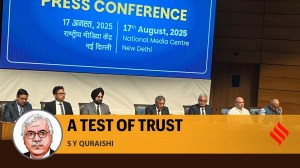A white paper put together by 58 organisations and air quality experts has urged the Ministry of Environment, Forest and Climate Change (MoEFCC) to make the upcoming National Clean Air Programme (NCAP) 2.0 wider in scope, sharpen focus on PM 2.5 pollution, and make it more efficient and accountable on outcomes.
It has also made a slew of recommendations to the ministry on strengthening air quality monitoring, covering a larger area to reduce air pollution, and improving performance evaluation.

The signatories included environmental groups, public health advocates, experts from Indian Institute of Technology, researchers and civil society organisations.
Story continues below this ad
The NCAP was launched in 2019 to improve air quality in 131 cities across 24 states, which were chosen for sustained poor air quality. These cities have to cut air pollution levels by 40 percent by 2025-26, with 2019-20 as the base year. Of 131 cities, 82 are those that do not conform to national ambient air quality standards and 49 are cities with over a million people.
Since NCAP is funded by multiple sources, including the 15th Finance Commission, this is the last year in the present commission period.
The white paper said that air pollution was not confined by administrative boundaries, and thus NCAP 2.0 must extend beyond the 131 cities to include peri-urban and rural regions. Multiple studies have shown transboundary impacts of particulate matter pollution.
“Our analysis shows that most NCAP cities still breach national air quality standards, and rural India remains largely invisible in monitoring systems. The next phase must close these gaps by mapping pollution across urban, rural, and interconnected regions, and by tying public funding to verified reductions in emissions sector by sector,” said Nandikesh Sivalingam, Director and Co-founder, Centre for Research on Clean Air and Energy, an independent research organisation.
Story continues below this ad
One of the key recommendations to the environment ministry was to revamp the performance-linked grant framework to move beyond outcome-only indicators such as PM 10 reduction or ‘number of good AQI days’. These metrics have proven to be inadequate, the white paper said.
It urged the government to take into account absolute reduction in PM 2.5 concentration, along with PM10, and link budgetary allocations directly to sectoral and department-wise pollutant depreciation at city and state levels for more accountability. Last year, a Centre for Science and Environment analysis also found that dust mitigation was cornering 64 per cent of NCAP funds.
From funding to emission reduction targets
The Centre has released Rs 1,615.48 crore to 82 cities between 2019-20 and 2024-25 as per official data and an amount of Rs 801 crore has been sanctioned for financial year 2024-25. These funds are being released in tranches of 25 per cent each to states.
Spending from the funds allocated for 2024-25 was delayed as the ‘control of pollution’ scheme was approved late, the ministry had informed a House panel earlier this year. However, the ministry will carry forward the unspent funds from 2024-25 to prevent any surrender of funds.
Story continues below this ad
Further, the white paper stressed on conducting state-level modelling to set realistic emission reduction targets, which are aligned with the national ambient air quality standards. It advocated for stricter PM 2.5 standards for different regions, such as 35 ug/m3 (micrograms/cubic metre) annual average or lower as a national regulatory target for Indo-Gangetic plains region and 25 ug/m3 (annual average) for states with cleaner airsheds.
As per the NCAP dashboard, only 27.69 per cent of cities have completed source apportionment and emission inventory status reports, and work is under progress in 71.54 per cent cities.
On monitoring, the white paper advocates for strengthening the network of air quality measuring stations. It said that the existing 560 continuous ambient air quality monitoring stations (CAAQMS) and over 800 manual monitoring stations are not sufficient. “Many cities have just one CAAQMS, and most/all rural areas have zero continuous stations.”
The MoEFCC, the paper said, may consider independent audits of monitoring stations to ensure compliance of site selection parameters. On institutional monitoring, the white paper suggested a national working group for NCAP 2.0, and sectoral groups for transport, industry and biomass. These sectors contribute heavily to air pollution in several cities and towns.









